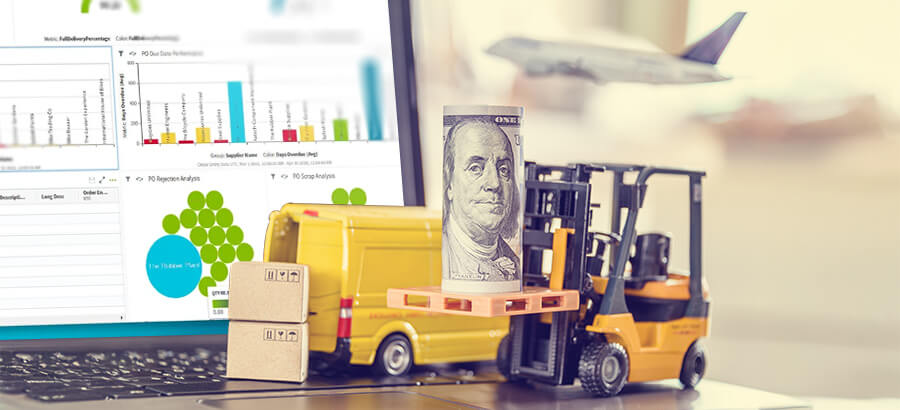Years ago, when I was working as a production planner at a manufacturing company, I would often receive calls or emails from our customer service representatives asking when a particular job would be completed. The customer wanted to know.
To answer their simple question, was not so simple. I had to leave my desk, walk around in the plant, ask the supervisors or operators for updates, then message the representative. Doing this many times per day wasted a lot of time. Worse yet, sometimes the supervisors or operators could only provide guesstimates.
Does this sound familiar? The problem was, we had no way to track what was happening on the shop floor. Not only did our front office staff lack visibility to what was happening in the plant, our plant managers did too. For those of you who still track labour data – think employees starting and stopping their shifts, and activity on machines – on timecards and spreadsheets, you know all too well the kinds of frustration manual processes can cause:
Errors that creep in from manually transferring data into your ERP system. This makes data unreliable up and down the entire organization, from your estimators to your payroll staff. They also drain time as your employees track down and fix mistakes, and money in lost productivity and inaccurate estimates.
Incorrect costs for labour and production. When you don’t know exactly how many hours it takes to do the work, you probably don’t have a clear idea of your margins, and your quotes may be based on guesswork. That can be costly, as underestimating leaves money on the table, but overvaluing can mean more business lost to competitors.
Outdated data, or data discrepancies between different departments. If you need to make a critical decision, you don’t want yesterday’s numbers. The same goes when functions like planning and scheduling rely on the same data to get their jobs done. Mismatched, historical figures just won’t do.
These issues are why I’m a huge believer in digital shop floor management.
Eliminate the pain of paper-based processes
First, a quick primer on digital shop floor management. Think of it as a way of collecting real-time labour data from your plant operations and making it accessible to everyone who needs it via a single, easy-to-use platform. It can track everything from when your employees clock in and out for the day and which jobs they’re working on to how long projects take to complete and even which machines are causing bottlenecks.
Digitizing that information – and integrating it with your ERP platform – is a powerful way to not only eliminate the pain points of tracking data manually (or not tracking it at all), but also increase the profitability of your organization through:
Automated data capture: Every time an employee clocks in for the day or begins a new project, data is sent directly to your ERP system. This saves time as employees no longer need to re-key information into a second system, while drastically cutting costly errors that waste both time and money.
Reliable, real-time data: When your data is riddled with errors – or when it’s constantly out-of-date – can you really trust it? The great thing about automation is, it can deliver visibility and accuracy across your organization as quickly as things happen on your shop floor.
Ease of use: Not everyone is a computer whiz – and that’s okay! Best-of-breed shop floor management systems like SYSPRO ShopClock require little set-up configuration. Plus, clocking in and out is as simple as a scan or a tap for your shop floor staff.
One system of record: Keeping all of your labour data in one place means different departments have access to the same numbers, at the same time – a key benefit that leads to better collaboration and decision-making across the organization.
Flexible ways of working: Your shop floor management system should be flexible enough to capture the data that’s most important to your organization. By setting up your rules, your way, you make sure you’re collecting – and sharing – the metrics that matter most to your unique organization.
Shop floor management that’s smart and effective
So, what does this look like in practice? Let me share a few results that I’ve seen with manufacturers that have automated labour data collection.
Improved customer service
Having real-time visibility of job progress allows you to promise more accurate delivery dates to customers.
Save time
No more walking around to find out a job’s progress. Plant management and salespeople can quickly and easily look it up.
Improved capacity usage
Real-time visibility of which people are working on which machines allows you to see bottlenecks and make changes accordingly.
Quote more accurately
When you track shop floor data in detail, you know exactly how much labour is involved – and time is money. When quoting the next project, you now know your own costs better and can provide a quote that you know is profitable.
Save money
Errors are costly. Automated data collection means no one is wasting resources tracking down and fixing mistakes – and mistakes that would otherwise slip through the cracks can be flagged automatically, preventing further loss of profitability.
Make data-driven decisions
Having visibility on your labour data lets you see where your resources are currently being spent and make decisions about how to allocate them more effectively. This impacts everything from recruiting more staff to pricing products.
Improve productivity
Automated labour data collection liberates employees of repetitive, manual tasks such as completing manual timesheets and entering that data into your ERP. This frees them to focus on revenue-generating activities.
Ready to get started with digital shop floor management? Watch this webinar to learn more.






